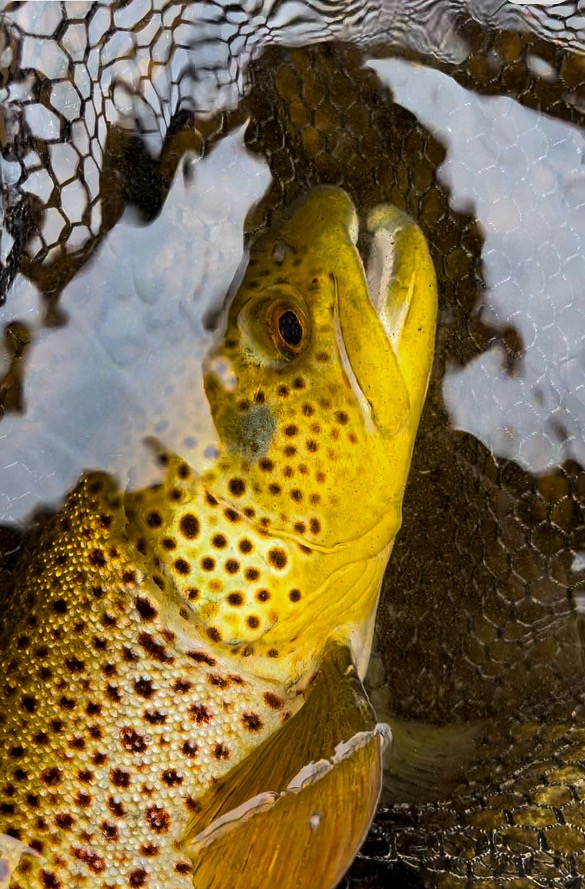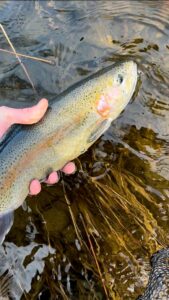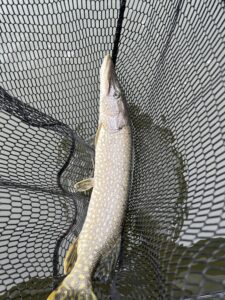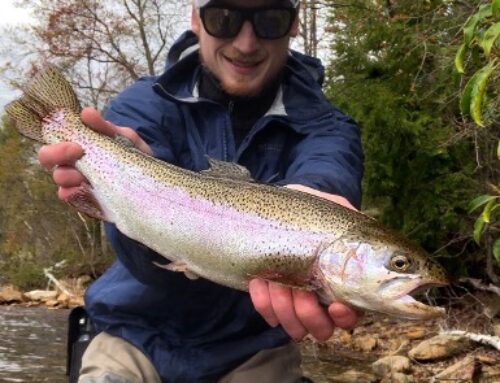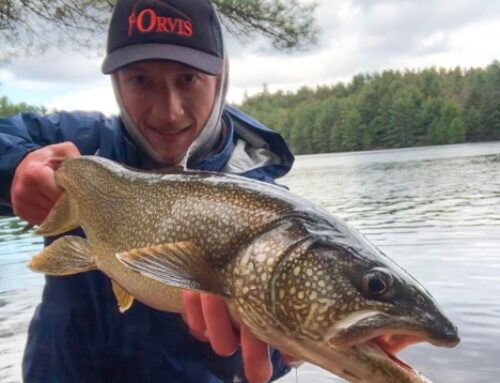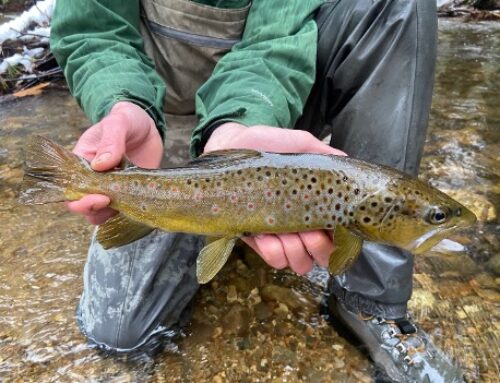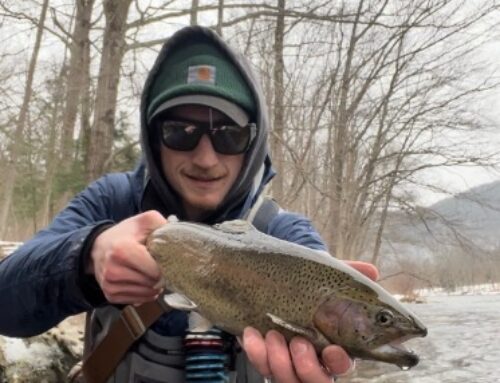WELCOME TO SPRING! With the days getting longer and warmer and nights not so chilly, some of the year’s best fishing is upon us.
As is usual around this time of year, runoff from heavy rains and snowmelt higher up in watersheds can drastically affect fishing conditions on a day-to-day basis. Productive wade fishing can still be had in higher flows but be aware of your limits in navigating powerful high water. Keep a close watch on flow rates for downtrends—periods of time in which flows are consistently falling after a fixed high point—whicoffer some of the best windows for size and numbers throughout the year. These intervals will often be ‘post-front,’ occurring in the days following significant rainfall/runoff when a lot of environmental factors like overhead conditions or barometer are shifting favorably.
As for what’s fishing, the Deerfield has continued to be productive. With milder weather, the fish start to key in more on the smaller insect hatches common at this time of year. That’s not to say larger patterns like a Pat’s rubber legs or other big stones won’t turn a few heads, but smaller options imitating little black stones, black caddis, BWOs and midges are generally a little closer to what most fish are feeding on right now. A few great options currently fishing productively in this regard are jigged D-rib stonefly nymphs (#14-18), quasimodos (#14-18) and midge variants (#18-22), especially in intervals of lower water in the latter case. Also keep in mind that we are in the heart of junk season. Leeches and worms are abundant as they get flushed around the watershed; and make sure to keep in mind that many fish like suckers, sculpin and even wild rainbow trout are spawning at this time of year, so there are plenty of eggs kicking around the system and trout really like their eggs!
Streamer fishing on the D continues to be productive, especially for larger brown trout. Don’t be afraid to go pretty big on presentations such as a drunk & disorderly or Strolis alter-ego; both large, hackle-tail articulated options. When stripping or swinging such patterns you may find yourself looking for that one bite, but it’s usually a good one when it comes. Smaller presentations like a bank robber or Heisenberg are usually good for a few more looks than their larger counterparts but are still more than competitive enough for larger-class fish. Don’t forget that many sculpins spawn around this time and are a valuable forage option for many of the river’s larger predators. Sculpin helmet patterns like the Strolis headbanger are excellent options for getting down to the bottom where spawning activity takes place, however, options like the bank robber or Galloup’s zoo cougar—which are intended to imitate sculpin flushed from the bottom up into the water column—are often sought out aggressively by predators.
In a final word on the Deerfield, be prepared for some upcoming opportunities at the surface. As this report is being written the river is running a sporty 4.5K CFS so we wouldn’t say head out with your dry box tomorrow. However, more normalized flow cycles should yield ample surface opportunities during low periods (125-350 CFS). Hatch activity is limited at this time making it relatively easy to match. Most rises will be on midges for now, however, keep eyes closely peeled for the increasing presence of BWOs and black caddis. Keep in mind that early season olives are relatively large (#16-18) and often the best conditions window to find them will be immediate pre or post-front with overcast overhead. Favorite one-size-fits-all selections for both midge and olive imitation are the Craven mole fly, smoke jumper and other CDC emergers. Larger presentations like parachute Adams or klinkhammers might get a look here and there but can also be deadly as point flies to drop something a little wispier off of like an RS2, black beauty, or other small, emergent selections.
Keep in mind that larger mayflies like Quill Gordons and Hendricksons are right around the corner. While I would not expect to see the adults until the water temps are consistently cresting 50 degrees, a few weeks away still, the nymphs are getting active and will become more and more important to the trout. Size 12 to 16 pheasant tails and olive hare’s ears are good imitations for this.
Elsewhere, the Millers and Westfield Rivers have now been stocked and will fish increasingly better as water levels continue to normalize. Remember that stocked fish are conditioned to feed on pellets and need time in the river to acclimate to natural feeding cycles. In the meantime, many new stockies will hit just about anything that moves and you often cannot go wrong with a simple woolly bugger or other basic streamer. In the event that you run into a bit of a tighter-lipped group of them, switching to pellet-like flies such as a McFly egg is usually a winning ticket. As these new fish get acclimated, begin thinking about similar considerations outlined above for the Deerfield as both the Millers and Westfield will fish similarly.
The same will often be true in smaller rivers and creeks that are stocked. Wherever they’re put, new stockies tend to behave as a sort of hive-mind for a good while after they’re dropped before starting to split up and distribute across various fisheries. In small water that also holds a lot of wild fish you’ll tend to find that the naturally occurring individuals get out of dodge during the stockie madness but will increasingly return back to normal cycles as the stocked fish get both harvested and further distributed.
As for the Swift River, fish have been stocked but flows remain all but unfishably high, especially in the clear water sections further upriver. If you find yourself fishing around Rt. 9 (either above or below), plan to be up on the bank slotting in a contact rig with heavy flies where you can. The lower river is a bit more approachable but certainly not a walk in the park at these flows. Keep eyes peeled on flow rates for downtrends and plan to focus heavily on the river’s margins where a lot of fish will be pushed into. Swift flows should continue to downtrend into May when there will likely be solid opportunities to take a shot at salmon, lakers and even big smallmouth that have spilled over from the adjacent Quabbin Reservoir.
Speaking of bass, the pre-spawn window is upon us if you can believe it. High, cold flows in rivers like the Connecticut, Deerfield, and Millers can make keying in on pre-spawn smallmouth a bit tough for right now, but opportunities should become ample as flows regulate. A great option for both bass and even lake trout and/or salmon is the Wachusett Reservoir which opened this past weekend. Pike fishing is pretty solid right now as these beasts are definitely in post-spawn mode and eating well. Smallies will tend to be pretty deep right now but will continue making moves towards shallower spawning grounds. In addition to flows, keep a close eye on water temperature as most spawning behavior is dependent on it. Lastly, don’t overlook largemouth opportunities. Still water fisheries where they are most common tend to warm up much quicker than the rivers and the next few weeks are one of the year’s best windows to lock horns with a big bucket-mouth. In terms of approach for both largemouth and smallmouth, it’s usually best to start small, low, and slow with presentation before working larger patterns on quicker retrieves higher in the water column.
Off the water, we have several events coming up like the Women’s Fly Fishing Retreat instructed by the incomparable Cynthia Harkness of Fearless Fly Fishing (May 3-4), the “Trout Bum to Saltwater Slayer” class instructed by Capt. George Sylvestre (April 28). For registration and additional information visit our website at deerfieldflyshop.com or feel free to give us a call. We’ll also have more clinics, classes and events coming soon as well as an online shop, so keep eyes peeled, and good luck on the water in the coming weeks!


